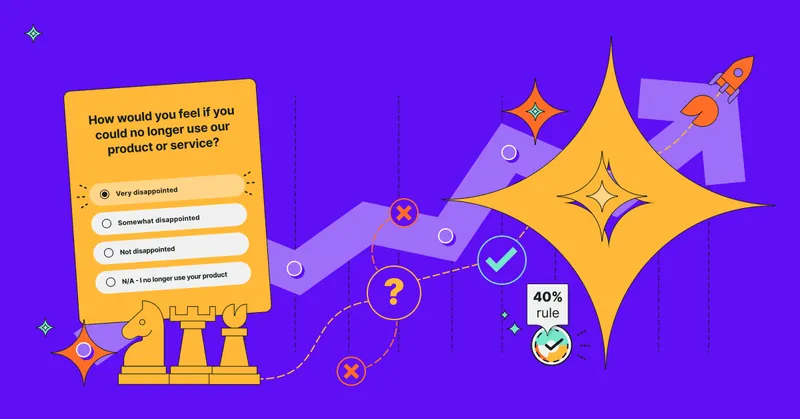tl;dr
- A successful Go-to-Market (GTM) strategy is essential for a product's market entry and involves a comprehensive approach that includes understanding the market, identifying the target audience, user segmentation, developing a clear value proposition, and aligning marketing and sales efforts.
- Market knowledge is crucial to achieve product-market fit, involving detailed analysis of the target audience, competition, and market trends to ensure the strategy is responsive to customer needs and market dynamics.
- Developing the GTM strategy requires clear definition of the value proposition, tailored marketing and sales plans, positioning and pricing research, and alignment across all teams to ensure consistent messaging and strategic coherence.
- Execution of the GTM plan involves careful product launch planning, customer engagement strategies, strategic promotion, selection of appropriate distribution channels, and ongoing feedback and measurement to refine the approach.
- Continual performance evaluation and adaptation in response to market feedback and trends are necessary to maintain relevance and effectiveness of the GTM strategy, ensuring long-term success and return on investment.
Developing a successful go-to-market (GTM) strategy is a critical step in ensuring that a product launch meets its objectives in terms of revenue, market penetration, and brand development.
A well-crafted GTM strategy provides you with a blueprint to reach your target customers and deliver your value proposition effectively. This approach aligns marketing, sales, and product development efforts to achieve a unified goal. It's important to understand that a GTM strategy is not a one-size-fits-all solution; it requires careful consideration of market dynamics, competitive landscape, and customer needs.

Understanding Your Market
To create a robust go-to-market strategy, you must have a comprehensive knowledge of the market landscape.
This involves pinpointing who will benefit most from your offering, understanding who you're up against, and staying abreast of market dynamics.
Your GTM strategy starts with defining the value proposition of your product. This is the core of your offering that differentiates it in the marketplace and answers the critical question of why customers should care about your product.
It should convey the unique benefits and solve a significant pain point for your target audience. With a clear value proposition, you can tailor your marketing and sales efforts to communicate this message effectively and resonate with potential customers.
When planning your GTM strategy, it’s essential to identify the channels that will connect your product with your target audience.
Whether it’s direct sales, partnerships, digital marketing, or a mix of various channels, the choices you make should be informed by where your customers are and how they prefer to discover and purchase products.
Ensuring that every aspect of your GTM strategy works cohesively towards delivering your value proposition will bolster your chances of a successful product launch.
Identifying Target Audience
Your target audience is the foundation of your go-to-market plan. You need to define who your target customers are with precision. For instance:
- Demographics: Age, gender, income, education
- Psychographics: Interests, values, lifestyle
- Behavioral traits: Buying habits, brand interactions
Analyzing Competition
Gaining a competitive advantage requires you to know your competition inside and out. Conduct a market analysis by:
- Creating a list of direct and indirect competitors.
- Evaluating their strengths, weaknesses, market positioning, and USPs.
Market Research and Trends
Market research is critical in understanding the broader market trends that could affect your go-to-market strategy. Perform qualitative and quantitative research to gather data on:
- Industry trends: New technologies, regulatory changes
- Consumer trends: Changing preferences, emerging needs
Employ this information to adapt and innovate your go-to-market strategy, ensuring it aligns with current and forecasted market conditions.
Developing a Strategic Approach
A successful go-to-market (GTM) strategy hinges on understanding your product's or service's value and how it will be communicated and sold to your potential customers. Precise planning in marketing, sales, and pricing is a backbone of every successful CMO marketing plan.
Crafting Your Value Proposition
Your value proposition is the cornerstone of your GTM strategy, concisely explaining why your product or service stands out from the competition.
Highlight your differentiators, such as unique features or superior service, in a way that resonates with your target audience. Consider using a table to clearly list:
Outlining Marketing and Sales Strategies
For both marketing and sales strategies, it's essential to determine the most effective channels and tactics to reach and convert your potential customers. Create separate lists for each strategy to ensure clarity.
- Determine the most impactful channels (e.g. social media, email, content marketing).
- Customize messaging to align with your value proposition.
- Engage in targeted advertising to reach potential customers.
Sales Strategy:
- Develop a sales process that's supported by the digital customer journey mapping.
- Train your sales team on addressing customer pain points with your product.
- Establish KPIs to measure sales success and adapt as needed.
Establishing Pricing and Positioning
Formulate your pricing strategy by considering cost, market demand, and competitor pricing. Your pricing should reflect the value your product or service provides while remaining competitive.
Product positioning involves the place your product holds in the minds of customers relative to competitors; make it distinct and desirable.
Creating Alignment Between Teams
Effective alignment across your teams is crucial to ensure a unified approach in bringing your product or service to the marketplace. This collaboration facilitates a streamlined go-to-market strategy that speaks directly to your target audience, fostering consistency in your messaging and accelerating market entry.
Collaboration Between Marketing and Sales
Your marketing and sales teams need to be in lockstep. Begin by establishing common goals and key performance indicators (KPIs) to measure success.
Utilize regular joint meetings to maintain open lines of communication and ensure both teams are aligned on the latest product features, target audience characteristics, and key messaging.
- Common Goals and KPIs: Create a table listing goals such as lead generation, conversion rates, and customer acquisition cost.
- Joint Meetings: Set up biweekly syncs to discuss progress, share feedback, and adapt strategies as necessary.
Product and Service Development Synchronization
Aligning your development team with marketing and sales ensures your go-to-market strategy reflects the latest product advancements and service offerings.
Your development team should be aware of the market demand and the unique selling propositions that the marketing and sales teams are promoting.
- Feedback Loops: Implement structured feedback loops where sales can report customer reactions and suggestions to the development team.
- Product Updates: Develop a system for communicating product updates to the marketing and sales teams, so they can adjust their strategies accordingly.
With these practices in place, your teams will operate cohesively, maximizing the impact of your go-to-market efforts.
Execution of GTM Plan
Successfully executing your Go-To-Market (GTM) plan requires a precise alignment of your product launch, promotion strategies, distribution channels, and continuous performance evaluation to make necessary adjustments.
This strategic execution will ensure that your go-to-market strategy communicates the value of your new product effectively to your target market.
Launching the Product
When launching your new product, timing and preparation are essential.
Firstly, create a comprehensive product launch checklist to confirm that all aspects of your product, such as features, pricing, and customer support, are ready for public release.
Secondly, synchronize your launch with marketing efforts to create a buzz and inform potential customers. This may involve:
- Coordinated release dates: Set a public launch date and ensure that all teams are ready.
- Media outreach: Contact industry influencers and press outlets to cover your launch.
- Launch event: Plan an interactive event to showcase the product and its benefits.
Promotion and Distribution Channels
Effective promotion and meticulously selected distribution channels are the lifeblood of your GTM plan.
To begin with, craft a marketing strategy that includes digital marketing tactics tailored to your target audience.
An effective promotion strategy could include:
- Digital marketing campaigns: Utilize SEO, social media, and email marketing to reach a wider audience.
- Content marketing: Create valuable content to educate and engage potential customers.
- Channel partnerships: Identify and partner with relevant channels to enhance reach.
For distribution, assess and choose channels that align with your marketing strategy and can best reach your target market.
Consider both online and offline channels for a diversified approach:
- Online channels: E-commerce platforms, company website, and online marketplaces.
- Offline channels: Retail partners, direct sales, and trade shows.
Feedback, Measurement, and Adjustment
Finally, in executing your GTM plan, it's important to establish a process for collecting feedback, measuring success, and making adjustments.
Utilize metrics and Key Performance Indicators (KPIs) to gauge the effectiveness of your launch and promotion efforts.
Implement feedback mechanisms such as:
- User surveys
- Usability testing
- Sales data
Based on these insights, be ready to make swift adjustments to your strategy for continuous improvement.
This could entail refining your messaging, utilizing different marketing channels, or addressing any identified product issues.
In summary, execution of your GTM plan requires detailed preparation, strategic promotion, thoughtful distribution channel selection, and a robust feedback loop to fine-tune and enhance your market strategy.
Mastering Customer Acquisition
Improving customer acquisition is essential to the success of your go-to-market (GTM) strategy.
It hinges on developing strong customer interactions, executing effective marketing campaigns, and minimizing customer acquisition costs to build a solid and engaged customer base.
Building Customer Relationships
To foster a loyal customer base, it's crucial to cultivate relationships built on trust and customer satisfaction.
Your product or service should exceed customer expectations and solve their pain points seamlessly.
Personalize your approach by creating buyer personas—detailed profiles of your ideal customers—which will guide you in tailoring your interactions and offerings.
- Engage Proactively: Reach out to prospects before they come to you. Implement communication channels such as newsletters and personalized emails.
- Feedback Loop: Encourage and act on customer feedback to continuously improve your product or service.
Leveraging Marketing Campaigns for Lead Generation
Effective marketing campaigns are a linchpin in driving a low-cost, high-impact customer acquisition strategy.
Your campaigns should resonate with your target audience and communicate the unique value proposition of your product or service.
- Content Marketing: Create valuable content that aligns with your buyer personas, leveraging blogs, videos, webinars, and eBooks.
- Social Media: Use social media platforms to run targeted ads and initiate conversations with potential customers.
Utilize analytics tools to measure the performance of your campaigns and refine your strategies accordingly.
Reducing Customer Acquisition Cost
To ensure the sustainability of your GTM strategy, keep your customer acquisition cost (CAC) within optimal limits.
Streamlining customer acquisition processes and enhancing conversion rates are pivotal here.
- Optimization: Investigate each marketing channel's performance and focus resources on the most effective ones.
- Referral Programs: Implement referral incentives to mobilize your existing customers to acquire new ones, thus reducing direct CAC.
By concentrating on these strategies, you can lay a foundation for sustained customer acquisition that contributes to the long-term success of your GTM strategy.
Evaluating Performance and ROI
Once your go-to-market strategy is operational, measuring its effectiveness is crucial for understanding the return on investment (ROI) and making informed decisions for future strategies.
Your focus should be on quantifying success through hard data from sales and marketing metrics, and effectively communicating these results to investors and stakeholders.
Analyzing Sales and Marketing Metrics
To gauge your go-to-market strategy's success, you should monitor specific sales and marketing metrics.
Track monthly sales growth to see the upward trajectory or demand for your product or service.
Evaluate customer acquisition cost (CAC) by dividing total marketing costs by the number of new customers acquired, to ensure you're spending effectively.
Examine the customer lifetime value (CLV) to sales ratio; this will provide insights into the long-term value each customer brings relative to your marketing costs.
Your ROI is critical—calculate it by subtracting the marketing costs from the net profit attributed to the marketing efforts, then divide this number by the marketing costs. For example:
ROI = (Net Prodit - Marketing Costs) /MarketingCosts
Analyze lead conversion rates to understand how many leads turn into customers, which can indicate the effectiveness of your sales strategies.
Pay attention to the sales cycle length to understand the time taken from the initial contact to closing a sale. Shorter cycles may imply a more efficient go-to-market strategy.
Investor and Stakeholder Reporting
Clear and accurate reporting to investors and stakeholders is essential for maintaining trust and support.
Present a distilled summary of key metrics such as sales figures, marketing expenditure, and changes in sales growth over time. Provide this data in a clear format, such as a table, to aid in the understanding of complex information:
Present a narrative that connects the data to the gtm strategy's objectives, demonstrating how the strategy has performed against predefined targets. Emphasize areas of success and identify any aspects that require adjustment. It's important that your reports have a balanced perspective, providing both positive outcomes and areas for improvement.
Continual Improvement and Innovation
To secure long-term success with your go-to-market (GTM) strategy, consider perpetual innovation and timely adjustments to remain aligned with evolving market conditions.
Responding to Market Changes
You need to monitor the market constantly to detect shifts that could affect your GTM strategy. Key Performance Indicators (KPIs) are invaluable for assessing whether you're on track or if the market dictates a change. Consider the following:
- Customer Feedback: Regularly collect and analyze feedback to understand the market's response to your product.
- Market Trends: Stay abreast of industry trends to anticipate necessary changes.
Leverage tools like social media analytics and market research reports to gather insights.

Pivoting Strategies When Necessary
When challenges arise, be prepared to pivot your strategy. This could mean shifting focus to a different customer segment, altering your value proposition, or even modifying your product. Here's how to pivot effectively:
- Assess the Situation: Determine the cause of deviation from your roadmap.
- Revise Your Timeline: Make alterations to your timeline to incorporate new objectives or phases.
- Adjust Your Roadmap: Based on your revised timeline, update your strategic roadmap with new milestones and goals.
A successful pivot involves clear communication across your organization to ensure that everyone understands the changes and the reasons behind them.
Wrapping up
In conclusion, developing a successful Go-to-Market strategy is essential for product launch success. It requires understanding your market, defining a strong value proposition, aligning your teams, and executing your plan meticulously. Remember to continuously collect and incorporate customer feedback to refine and enhance your strategy. By staying responsive to market and customer needs, you can ensure your GTM strategy remains effective and drives your product towards its goals.
Ready to start your journey with customer feedback? Sign up to our Business trial, no credit card required!













.svg)

.svg)



